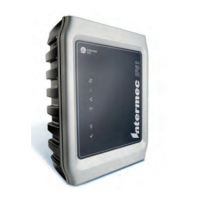Chapter 3 — Developing and Using RFID Applications
IF61 Fixed Reader User’s Manual 55
Creating RFID Applications for the IF61
Intermec recommends this general outline for developing your
RFID application:
1 Write and test your application on a development workstation
(your desktop PC). The application can access the IF61 via
TCP on port 2189.
2 After testing is complete, install the application on the IF61.
For help with installing applications on the IF61, see
“Installing RFID Applications on the IF61” on page 59.
Delivering Applications to the IF61
For Java applications:
• Create a .zip file that includes your Java application (.tar, .gz,
.bz2, or .zip format only), RFID Java libraries, and a
configuration file. Install the .zip file on the IF61 as described
in “Installing RFID Applications on the IF61” on page 59.
Be sure to specify the class path to the libraries.
For more information on configuration files, see the next
section.
For help with executing Java applications, see “Executing Java
Applications” on page 57.
For C# applications:
• Create a .zip file that includes your application (.exe), all
required DLLs, and a configuration file. Install the .zip file on
the IF61 as described in “Installing RFID Applications on
the IF61” on page 59.
For more information on configuration files, see the next
section.
Note: If you plan to auto-start your application when the
IF61 boots, Intermec recommends that you install your
software on the IF61 and start it manually to verify that the
executable or script runs properly. Then you can use the web
browser interface to configure the application to auto-start at
boot time. For information about starting an application
manually, see “Managing Applications” on page 60.

